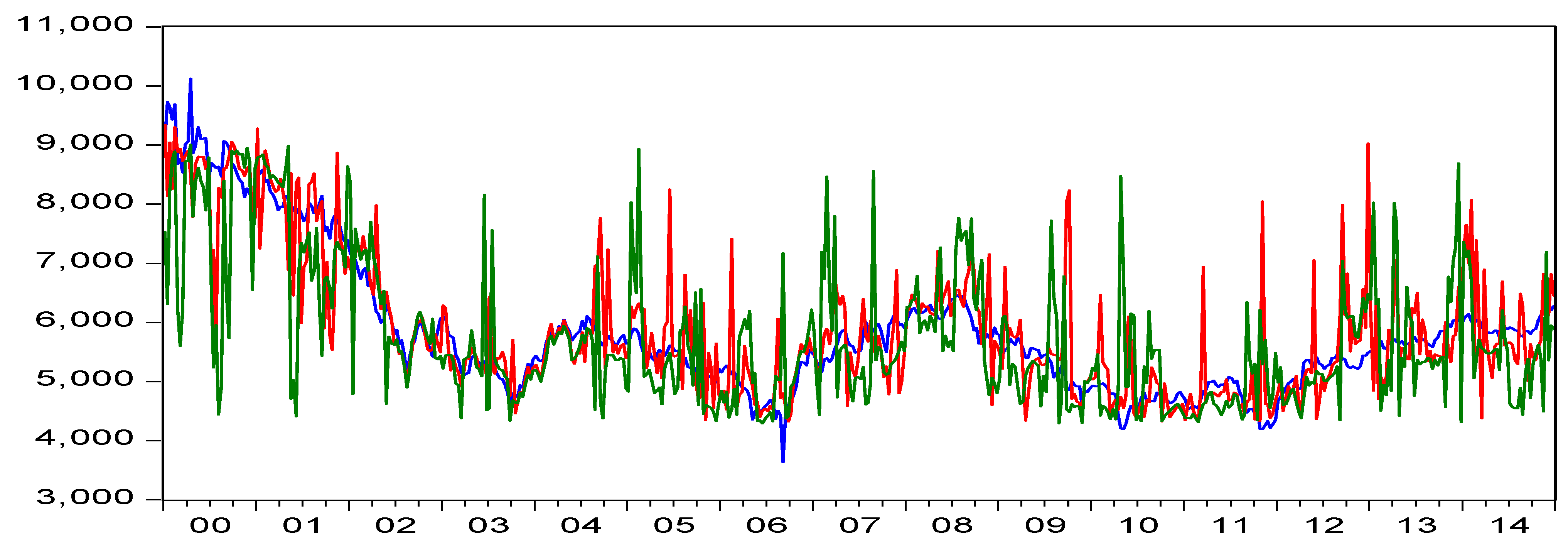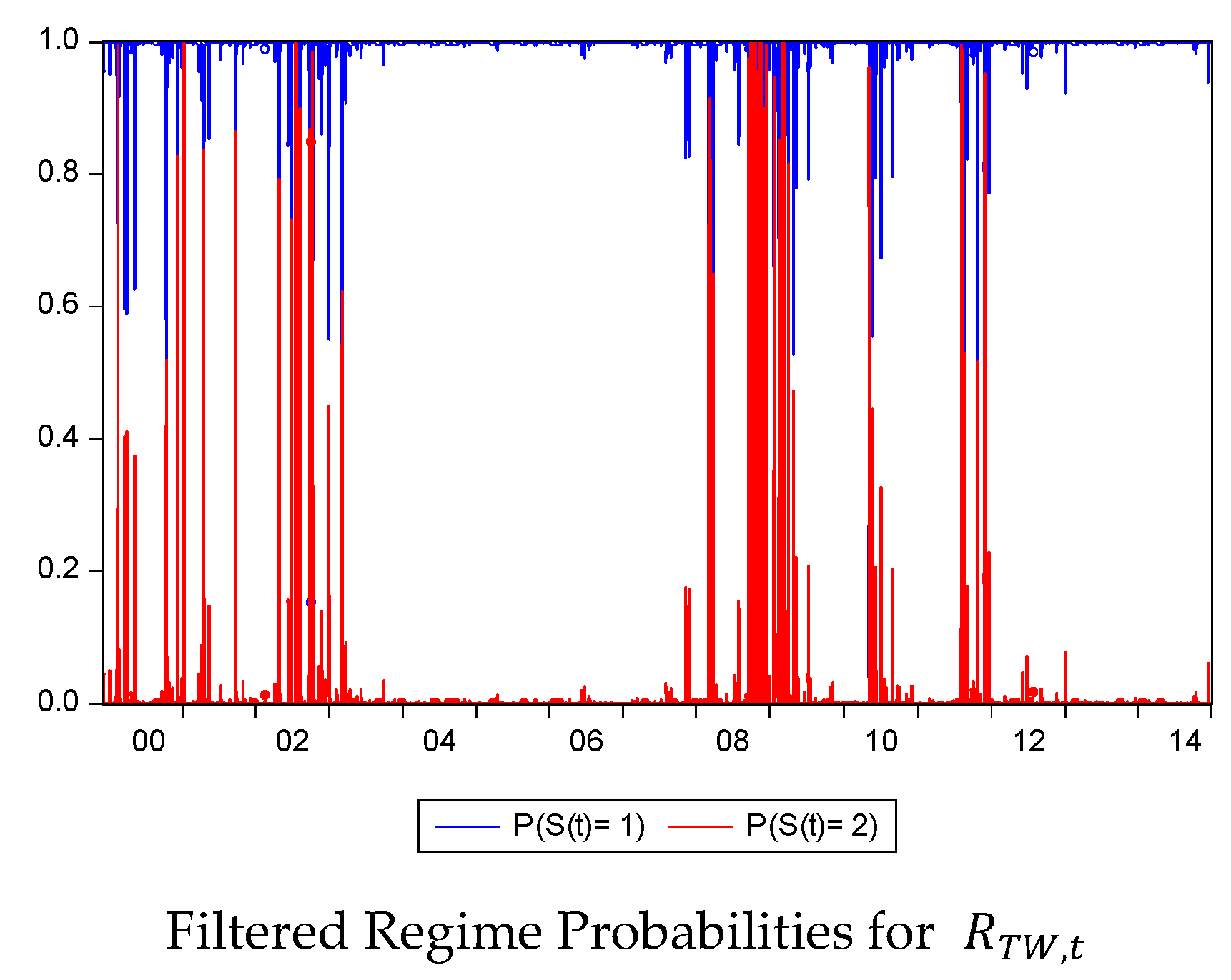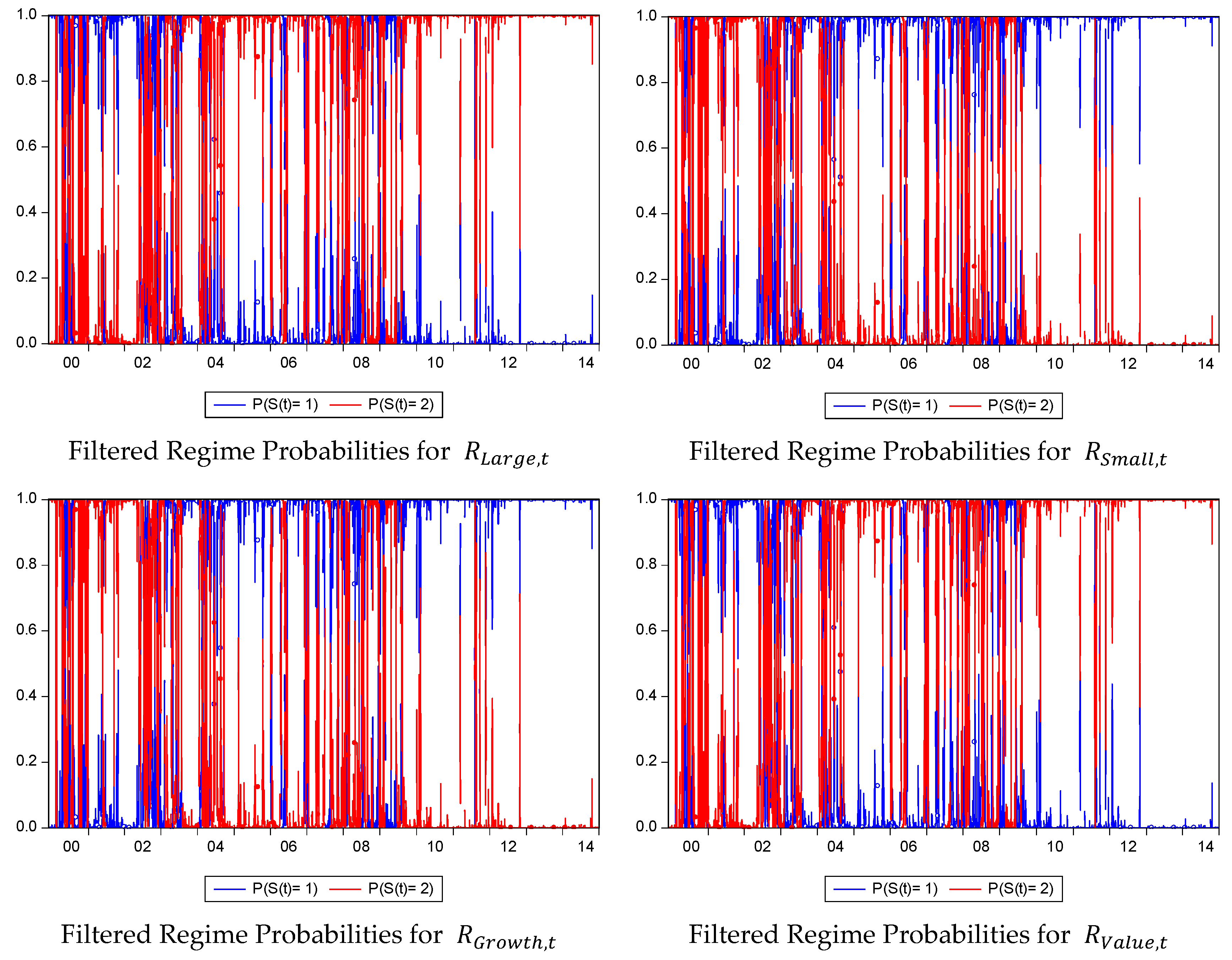A Transmission of Beta Herding during Subprime Crisis in Taiwan’s Market: DCC-MIDAS Approach
Abstract
:1. Introduction
2. Literature Review
2.1. Detecting Herding Behavior: A Short Review
2.2. A Look at Testing Methods
3. Data and Methodology
3.1. Herding Models
3.2. Time-Varying Beta of Herding Measures
3.3. Rolling Forecast Procedures
3.4. Data and Forecasting Time-Varying Beta of Herding Series
4. Empirical Analysis
5. Conclusions and Limitations
Author Contributions
Funding
Institutional Review Board Statement
Informed Consent Statement
Data Availability Statement
Acknowledgments
Conflicts of Interest
References
- Akhtaruzzaman, Md, Sabri Boubaker, and Ahmet Sensoy. 2021a. Financial contagion during COVID-19 crisis. Finance Research Letters 38: 101604. [Google Scholar] [CrossRef] [PubMed]
- Akhtaruzzaman, Md, Sabri Boubaker, Brian M. Lucey, and Ahmet Sensoy. 2021b. Is gold a hedge or a safe-haven asset in the COVID-19 crisis? Economic Modelling 102: 105588. [Google Scholar] [CrossRef]
- Allard, Anne-Florence, Leonardo Iania, and Kristien Smedts. 2020. Stock-bond return correlations: Moving away from “one-frequency-fits-all” by extending the DCC-MIDAS approach. International Review of Financial Analysis 71: 101557. [Google Scholar] [CrossRef]
- Asgharian, Hossein, Ai Jun Hou, and Farrukh Javed. 2013. The Importance of the Macroeconomic Variables in Forecasting Stock Return Variance: A GARCH-MIDAS Approach. Journal of Forecasting 32: 600–12. [Google Scholar] [CrossRef] [Green Version]
- Asgharian, Hossein, Charlotte Christiansen, and Ai Jun Hou. 2015. Effects of macroeconomic uncertainty on the stock and bond markets. Finance Research Letters 13: 10–16. [Google Scholar] [CrossRef] [Green Version]
- Asgharian, Hossein, Charlotte Christiansen, and Ai Jun Hou. 2016. Macro-finance determinants of the long-run stock–bond correlation: The DCC-MIDAS specification. Journal of Financial Econometrics 14: 617–42. [Google Scholar] [CrossRef]
- BenSaïda, Ahmed, Sabri Boubaker, and Duc Khuong Nguyen. 2018. The shifting dependence dynamics between the G7 stock markets. Quantitative Finance 18: 801–12. [Google Scholar] [CrossRef]
- Bikhchandani, Sushil, and Sunil Sharma. 2001. Herd Behavior in Financial Markets. IMF Staff Papers 47: 279–310. Available online: https://www.imf.org/External/Pubs/FT/staffp/2001/01/pdf/Bikhchan.pdf (accessed on 5 December 2021).
- Bikhchandani, Sushil, David Hirshleifer, and Ivo Welch. 1992. A Theory of Fads, Fashion, Custom, and Cultural Change as Informational Cascades. Journal of Political Economy 100: 992–1026. Available online: https://www.jstor.org/stable/2138632 (accessed on 5 December 2021). [CrossRef]
- Bohl, Martin T., Arne C. Klein, and Pierre L. Siklos. 2013. A Markov Switching Approach to Herding. CIGI Papers 21. Available online: https://www.cigionline.org/static/documents/no21_2.pdf (accessed on 5 December 2021).
- Boubaker, Sabri, and Jamel Jouini. 2014. Linkages between emerging and developed equity markets: Empirical evidence in the PMG framework. The North American Journal of Economics and Finance 29: 322–35. [Google Scholar] [CrossRef]
- Bouri, Elie, Riza Demirer, Rangan Gupta, and Jacobus Nel. 2021. COVID-19 pandemic and investor herding in international stock markets. Risks 9: 168. [Google Scholar] [CrossRef]
- Boyer, Brian H., Tomomi Kumagai, and Kathy Yuan. 2006. How do crises spread? Evidence from accessible and inaccessible stock indices. Journal of Finance 61: 957–1003. [Google Scholar] [CrossRef]
- Brooks, Robert D., Robert W. Faff, and Michael D. McKenzie. 1998. Time-Varying Beta Risk of Australian Industry Portfolios: A Comparison of Modelling Techniques. Australian Journal of Management 23: 1–22. [Google Scholar] [CrossRef]
- Cederburg, Scott, and Michael S. O’Doherty. 2016. Does it pay to bet against beta? On the conditional performance of the beta anomaly. The Journal of Finance 71: 737–74. [Google Scholar] [CrossRef]
- Chang, Charles. 2010. Herding and the role of foreign institutions in emerging equity markets. Pacific-Basin Finance Journal 18: 175–85. [Google Scholar] [CrossRef]
- Chang, Eric C., Joseph W. Cheng, and Ajay Khorana. 2000. An examination of herd behavior in equity markets: An international Perspective. Journal of Banking and Finance 24: 1615–79. [Google Scholar] [CrossRef]
- Cheung, Yin-Wong, Menzie D. Chinn, and Antonio Garcia Pascual. 2005. Empirical exchange rate models of the nineties: Are any fit to survive? Journal of International Money and Finance 24: 1150–75. [Google Scholar] [CrossRef] [Green Version]
- Chiang, Thomas C., Bang Nam Jeon, and Huimin Li. 2007. Dynamic correlation analysis of financial contagion: Evidence from Asian markets. Journal of International Money and Finance 26: 1206–28. [Google Scholar] [CrossRef]
- Choi, Kyongwook, and Shawkat Hammoudeh. 2010. Volatility behavior of oil, industrial commodity and stock markets in a regime-switching environment. Energy Policy 38: 4388–99. [Google Scholar] [CrossRef]
- Choudhry, Taufiq, and Hao Wu. 2008. Forecasting Ability of GARCH vs Kalman Filter Method: Evidence from Daily UK Time-Varying Beta. Journal of Forecasting 27: 670–89. [Google Scholar] [CrossRef]
- Christie, William G., and Roger D. Huang. 1995. Following the Pied Piper: Do Individual Returns Herd Around the Market? Financial Analysts Journal 51: 31–37. [Google Scholar] [CrossRef]
- Colacito, Riccardo, Robert F. Engle, and Eric Ghysels. 2011. A component model for dynamic correlations. Journal of Econometrics 164: 45–59. [Google Scholar] [CrossRef] [Green Version]
- Conrad, Christian, Karin Loch, and Daniel Rittler. 2014. On the macroeconomic determinants of long-term volatilities and correlations in US stock and crude oil markets. Journal of Empirical Finance 29: 26–40. [Google Scholar] [CrossRef]
- Demirer, Rıza, Karyl B. Leggio, and Donald Lien. 2019. Herding and flash events: Evidence from the 2010 Flash Crash. Finance Research Letters 31. [Google Scholar] [CrossRef]
- Devenow, Andrea, and Ivo Welch. 1996. Rational Herding in Financial Economics. European Economic Review 40: 603–15. [Google Scholar] [CrossRef]
- Engle, Robert. 2002. Dynamic Conditional Correlation: A Simple Class of Multivariate GARCH models. Journal of Business and Economics Statistics 20: 339–50. Available online: https://www.jstor.org/stable/1392121 (accessed on 5 December 2021). [CrossRef]
- Engle, Robert F., and Kevin Sheppard. 2001. Theoretical and Empirical Properties of Dynamic Conditional Correlation Multivariate GARCH. Discussion Papers. San Diego: Department of Economics, University of California. [Google Scholar] [CrossRef]
- Engle, Robert F., Eric Ghysels, and Bumjean Sohn. 2008. On the economic sources of stock Market volatility. AFA 2008 New Orleans Meetings Paper. [Google Scholar] [CrossRef] [Green Version]
- Faff, Robert W., David Hillier, and Joseph Hillier. 2000. Time Varying Beta Risk: An Analysis of Alternative Modelling Techniques. Journal of Business Finance and Accounting 27: 523–54. [Google Scholar] [CrossRef]
- Fang, Libing, Baizhu Chen, Honghai Yu, and Cheng Xiong. 2018. The effect of economic policy uncertainty on the long-run correlation between crude oil and the US stock markets. Finance Research Letters 24: 56–63. [Google Scholar] [CrossRef]
- Fei, Tianlun, and Xiaoquan Liu. 2021. Herding and market volatility. International Review of Financial Analysis 78: 101880. [Google Scholar] [CrossRef]
- Forbes, Kristin J., and Roberto Rigobon. 2002. No contagion, only interdependence: Measuring stock market co-movements. Journal of Finance 57: 2223–61. [Google Scholar] [CrossRef]
- Guo, Jiaqi, Phil Holmes, and Ali Altanlar. 2020. Is herding spurious or intentional? Evidence from analyst recommendation revisions and sentiment. International Review of Financial Analysis 71: 101539. [Google Scholar] [CrossRef]
- Hamilton, James D. 1989. A new approach to the economic analysis of nonstationary time series and the business cycle. Econometrica: Journal of the Econometric Society 57: 357–84. [Google Scholar] [CrossRef]
- Hansen, Peter R., and Asger Lunde. 2005. A forecast comparison of volatility models: Does anything beat a GARCH (1, 1)? Journal of Applied Econometrics 20: 873–89. Available online: https://www.jstor.org/stable/25146403 (accessed on 5 December 2021). [CrossRef] [Green Version]
- Hsieh, Shu-Fan. 2013. Individual and institutional herding and the impact on stock returns: Evidence from Taiwan stock market. International Review of Financial Analysis 29: 175–88. [Google Scholar] [CrossRef]
- Hwang, Soosung, Alexandre Rubesam, and Mark Salmon. 2021. Beta herding through overconfidence: A behavioral explanation of the low-beta anomaly. Journal of International Money and Finance 111: 102318. [Google Scholar] [CrossRef]
- Hwang, Soosung, and Mark Salmon. 2004. Market Stress and Herding. Journal of Empirical Finance 11: 585–616. [Google Scholar] [CrossRef] [Green Version]
- Kang, Sang Hoon, Sang-Mok Kang, and Seong-Min Yoon. 2009. Forecasting volatility of crude oil markets. Energy Economics 31: 119–25. [Google Scholar] [CrossRef]
- Klein, Arne C. 2013. Time-variations in herding behavior: Evidence from a Markov switching SUR model. Journal of International Financial Markets, Institutions and Money 26: 291–304. [Google Scholar] [CrossRef]
- Kumar, Ashish, K. N. Badhani, Elie Bouri, and Tareq Saeed. 2021. Herding behavior in the commodity markets of the Asia-Pacific region. Finance Research Letters 41: 101813. [Google Scholar] [CrossRef]
- Lakonishok, Josef, Andrei Shleifer, and Robert W. Vishny. 1992. The Impact of Institutional Trading on Stock Prices. Journal of Financial Economics 32: 23–43. [Google Scholar] [CrossRef] [Green Version]
- Lalli, William R. 2011. Handbook of Budgeting, 6th ed. New Rochelle, NY: Wiley Corporate F&A. [Google Scholar]
- Lee, Kyuseok. 2017. Herd behavior of the overall market: Evidence based on the cross-sectional comovement of returns. The North American Journal of Economics and Finance 42: 266–84. [Google Scholar] [CrossRef]
- Scharfstein, David S., and Jeremy C. Stein. 1990. Herd Behavior and Investment. The American Economic Review 80: 465–79. Available online: https://www.jstor.org/stable/2006678 (accessed on 5 December 2021).
- Shyu, Jonchi, and Hsin-Ming Sun. 2010. Do institutional investors herd in emerging markets? Evidence from the Taiwan stock market. Asian Journal of Finance and Accounting 2: 1. [Google Scholar] [CrossRef]
- Tan, Lin, Thomas C. Chiang, Joseph R. Mason, and Edward Nelling. 2008. Herding behavior in Chinese stock markets: An examination of A and B shares. Pacific-Basin Finance Journal 16: 61–77. [Google Scholar] [CrossRef]
- Virk, Nader, and Farrukh Javed. 2017. European equity market integration and joint relationship of conditional volatility and correlations. Journal of International Money and Finance 71: 53–77. [Google Scholar] [CrossRef] [Green Version]
- Wang, Hu, and Shouwei Li. 2021. Asymmetric Volatility Spillovers Between Crude Oil and China’s Financial Markets. Energy 233: 121168. [Google Scholar] [CrossRef]
- Wei, Yu, Yudong Wang, and Dengshi Huang. 2010. Forecasting crude oil market volatility: Further evidence using GARCH-class models. Energy Economics 32: 1477–84. [Google Scholar] [CrossRef]
- Welch, Ivo. 1992. Sequential Sales, Learning and Cascades. Journal of Finance 47: 695–732. [Google Scholar] [CrossRef]
- Wermers, Russ. 1999. Mutual fund herding and the impact on stock prices. Journal of Finance 54: 581–622. [Google Scholar] [CrossRef]
- Zhang, Yuanyuan, and Taufiq Choudhry. 2013. Forecasting the daily dynamic hedge ratios by GARCH models: Evidence from the agricultural futures markets. The European Journal of Finance 21: 376–99. [Google Scholar] [CrossRef]
- Zhou, Rhea Tingyu, and Rose Neng Lai. 2009. Herding and information based trading. Journal of Empirical Finance 16: 388–93. [Google Scholar] [CrossRef]





| Mean | 0.019 | 0.071 | 0.080 | 0.138 | 0.160 | 0.066 |
| Mid | 0.018 | 0.254 | 0.197 | 0.557 | 0.418 | 0.132 |
| Max | 0.047 | 0.116 | 0.066 | 0.062 | 0.065 | 0.067 |
| Min | 0.004 | −0.090 | −0.067 | −0.065 | −0.066 | −0.067 |
| Std. Dev. | 0.005 | 0.013 | 0.015 | 0.013 | 0.016 | 0.015 |
| Kurtosis | 1.010 | 0.071 | −0.076 | −0.549 | −0.253 | 0.007 |
| Skewness | 4.376 | 10.811 | 5.469 | 5.590 | 5.041 | 5.453 |
| Jarque–Bera | −27.43 *** | −21.38 *** | −21.46 *** | −31.29 *** | −31.40 *** | −21.74 *** |
| Obs. | 3746 | 3746 | 3746 | 3746 | 3746 | 3746 |
| 1.000 | ||||||
| −0.008 | 1.000 | |||||
| −0.011 | 0.998 | 1.000 | ||||
| −0.043 | 0.800 | 0.801 | 1.000 | |||
| −0.009 | 0.839 | 0.833 | 0.900 | 1.000 | ||
| −0.009 | 0.977 | 0.980 | 0.740 | 0.738 | 1.000 |
| Full Periods | Subprime Crisis Periods | |||
|---|---|---|---|---|
| Variable | Cov. (Raw Return & CSAD) of DCC-MIDAS | Cov. (Raw Return & CSAD) of DCC-MIDAS | ||
| Panel 1: Taiwan market returns | ||||
| A | 0.2907 *** | (0.0233) | 0.0263 *** | (0.0771) |
| B | 0.6717 *** | (0.0206) | 0.9611 *** | (0.0099) |
| Omega | −0.0207 *** | (0.0148) | 0.7845 *** | (0.0327) |
| AIC | −14.1036 | −13.1423 | ||
| Panel 2: Large portfolio | ||||
| A | 0.0859 *** | (0.0054) | 0.2353 *** | (0.0685) |
| B | 0.9040 *** | (0.0064) | 07277 *** | (0.0505) |
| Omega | −0.3186 *** | (0.0287) | −0.0503 *** | (0.0647) |
| AIC | −13.4209 | −13.525 | ||
| Panel 3: Small portfolio | ||||
| A | 0.2853 *** | (0.0166) | 0.1387 *** | (0.0293) |
| B | 0.6822 *** | (0.0198) | 0.7637 *** | (0.0582) |
| Omega | −0.0336 *** | (0.0198) | −0.1679 *** | (0.0558) |
| AIC | −13.6953 | −13.1546 | ||
| Panel 4: Growth portfolio | ||||
| A | 0.0604 *** | (0.0111) | 0.2357 *** | (0.0687) |
| B | 0.9358 *** | (0.0101) | 0.7273 *** | (0.0505) |
| Omega | −0.0133 *** | (0.0498) | −0.0397 *** | (0.0668) |
| AIC | −13.1631 | −13.4491 | ||
| Panel 5: Value portfolio | ||||
| A | 0.2907 *** | (0.0233) | 0.2361 *** | (0.0671) |
| B | 0.6722 *** | (0.204) | 0.7277 *** | (0.0502) |
| Omega | −0.0460 *** | (0.0141) | −0.1230 *** | (0.0602) |
| AIC | −13.8399 | −13.3731 | ||
| Mean | Variance | Skewness | Kurtosis | JB | |
|---|---|---|---|---|---|
| Full periods | |||||
| Raw_tw | −0.0693 | 0.0278 | 0.0566 | 16.6787 | 421.0217 *** |
| 5 days | −0.0976 | 0.1266 | −0.3291 | 7.3884 | 443.1247 *** |
| 10 days | −0.0407 | 0.1552 | 0.0178 | 7.3887 | 443.1654 *** |
| Subprime crisis | |||||
| Raw_tw | −0.4440 | 0.0256 | 0.1707 | 4.2872 | 12.1188 ** |
| 5 days | −0.2097 | 0.1475 | −0.1530 | 6.4298 | 81.0289 *** |
| 10 days | −0.0428 | 0.1475 | 0.8753 | 6.2380 | 92.58827 *** |
| Up days | |||||
| Raw_tw | 0.0119 | 0.0144 | 4.8033 | 50.8732 | 1133.457 *** |
| 5 days | 0.0357 | 0.1019 | 1.7465 | 7.9026 | 1573.286 *** |
| 10 days | 0.0418 | 0.1221 | 2.0291 | 8.0699 | 1831.033 *** |
| Down days | |||||
| Raw_tw | −0.0130 | 0.0158 | −3.7524 | 28.4727 | 3061.683 *** |
| 5 days | −0.0092 | 0.1349 | −0.1578 | 8.1069 | 1136.689 *** |
| 10 days | −0.0134 | 0.1445 | −0.1700 | 7.6447 | 941.6837 *** |
| Probability Parameters | Transition Probability (Regime 1) | Transition Probability (Regime 2) | ||||
|---|---|---|---|---|---|---|
| 0.0369 | −1.0086 *** | 1.2016 *** | −4.4443 *** | 0.5092 | 0.4907 | |
| 0.0982 | −0.1151 *** | 0.1426 *** | −5.3608 *** | 0.5245 | 0.4754 | |
| −3.2619 *** | −0.0291 *** | −0.0052 | −5.6868 *** | 0.9853 | 0.0146 | |
| −4.3956 *** | 1.7039 *** | −0.8776 *** | −4.3956 *** | 0.4117 | 0.5882 | |
| 3.2365 *** | 0.0006 | −0.0097 * | −5.6863 *** | 0.9621 | 0.0378 |
Publisher’s Note: MDPI stays neutral with regard to jurisdictional claims in published maps and institutional affiliations. |
© 2021 by the authors. Licensee MDPI, Basel, Switzerland. This article is an open access article distributed under the terms and conditions of the Creative Commons Attribution (CC BY) license (https://creativecommons.org/licenses/by/4.0/).
Share and Cite
Chen, Y.-C.; Wu, H.-C.; Zhang, Y.; Kuo, S.-M. A Transmission of Beta Herding during Subprime Crisis in Taiwan’s Market: DCC-MIDAS Approach. Int. J. Financial Stud. 2021, 9, 70. https://doi.org/10.3390/ijfs9040070
Chen Y-C, Wu H-C, Zhang Y, Kuo S-M. A Transmission of Beta Herding during Subprime Crisis in Taiwan’s Market: DCC-MIDAS Approach. International Journal of Financial Studies. 2021; 9(4):70. https://doi.org/10.3390/ijfs9040070
Chicago/Turabian StyleChen, Yi-Chang, Hung-Che Wu, Yuanyuan Zhang, and Shih-Ming Kuo. 2021. "A Transmission of Beta Herding during Subprime Crisis in Taiwan’s Market: DCC-MIDAS Approach" International Journal of Financial Studies 9, no. 4: 70. https://doi.org/10.3390/ijfs9040070






